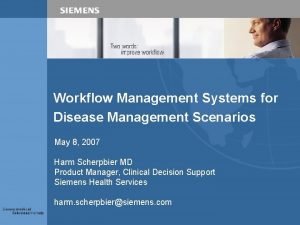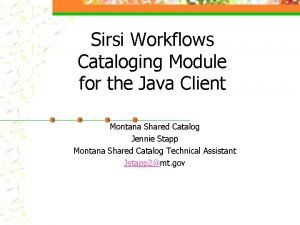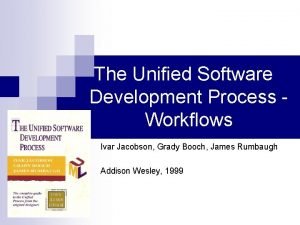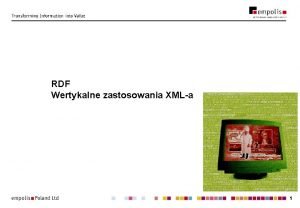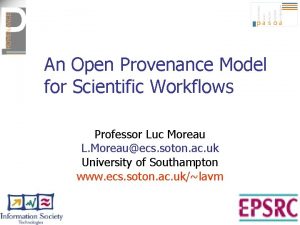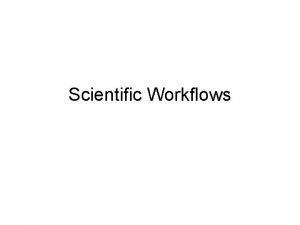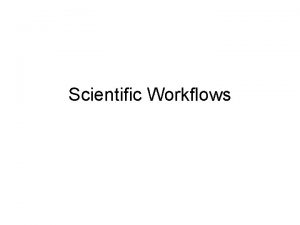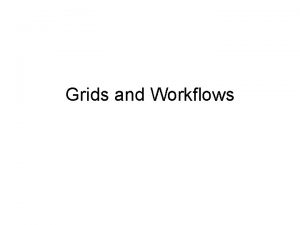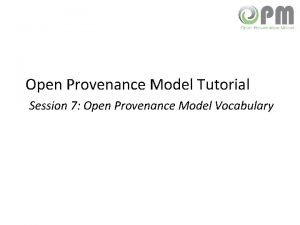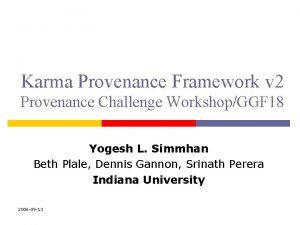Provenance in Scientific Workflows on SEEK Mark Schildhauer










- Slides: 10

Provenance in Scientific Workflows on SEEK Mark Schildhauer National Center for Ecological Analysis and Synthesis LTER Data QA session, Las Cruces, Feb. 1, 2007

Kepler Collaboration • Open-source – Builds on Ptolemy II from UC Berkeley • Collaborators – – – SEEK Project Sci. DAC SDM Center Ptolemy Project GEON Project ROADNet Project Resurgence Project • Goals – Create powerful analytical tools that are useful across disciplines – Ecology, Biology, Engineering, Geology, Physics, Chemistry, Astronomy, … Ptolemy II

Scientific Workflow approach Think of ecological analysis and modeling as a sequence of “steps”– or modules (indicating data and analytical processes), which are joined by arrows (which indicate “flow”): Resembles traditional “flow chart” approach to documenting analyses But modern Scientific Workflow applications are very different, because you can execute these workflows

Scientific Workflow approach Complex analyses and models can be constructed and executed using scientific workflow tools:

Kruger Park Buffalo Thresholds Reports and graphics are depicted as they are calculated, and can be saved for later review or distribution

Initial Work on Provenance Framework (next 4 slides from Altintas, SDSC) • Provenance – Track origin and derivation information about scientific workflows, their runs and derived information (datasets, metadata…) • Need for Provenance – – Association of process and results reproduce results “explain & debug” results (via lineage tracing, parameter settings, …) optimize: “Smart Re-Runs” • Types of Provenance Information: – Data provenance • Intermediate and end results including files and db references – Process (=workflow instance) provenance • Keep the wf definition with data and parameters used in the run – Error and execution logs – Workflow design provenance (quite different) • WF design is a (little supported) process (art, magic, …) • for free via cvs: edit history • need more “structure” (e. g. templates) for individual & collaborative workflow design

Kepler Provenance Recording Utility • Parametric and customizable – Different report formats – Variable levels of detail • Verbose-all, verbose-some, medium, on error – Multiple cache destinations • Saves information on – User name, Date, Run, etc…

Provenance: Possible Next Steps • More Provenance Meeting – Deciding on terms and definitions –. kar file generation, registration and search for provenance information – Possible data/metadata formats – Automatic report generation from accumulated data – A GUI to keep track of the changes – Adding provenance repositories – A relational schema for the provenance info in addition to the existing XML – Storage syntax: MOML? EML? Hybrid?

What other system functions does provenance relate to? • • Failure recovery Re-run only the updated/failed parts Smart re-runs Semantic extensions Kepler Data Grid Reporting and Documentation Guided documentation generation and updates Authentication Data registration

Acknowledgements This material is based upon work supported by: The National Science Foundation under Grant Numbers 9980154, 9904777, 0131178, 9905838, 0129792, and 0225676. Collaborators: NCEAS (UC Santa Barbara), University of New Mexico (Long Term Ecological Research Network Office), San Diego Supercomputer Center, University of Kansas (Center for Biodiversity Research), University of Vermont, University of North Carolina, Napier University, Arizona State University, UC Davis The National Center for Ecological Analysis and Synthesis, a Center funded by NSF (Grant Number 0072909), the University of California, and the UC Santa Barbara campus. The Andrew W. Mellon Foundation. Kepler contributors: SEEK, Ptolemy II, SDM/Sci. DAC, GEON, Road. Net, EOL, Resurgence


